UPDATE: Monash University has updated its Reintroduction protocols as of April 2025. Certain foods that were used for Challenges before were retested; some were found to have higher FODMAP content than before, some lower, and avocados were found to contain perseitol, a unique carbohydrate. This is not surprising. Please review our article, When Low FODMAP Lab Test Results Differ. In Monash researchers’ own words: “It is important to note that these changes do not mean previous reintroduction trials were a waste of time… These changes also reiterate the importance of continuing to re-test your tolerance to foods! Not only can your tolerance change, but so can the food supply.”
This article will be updated, but for now, you can use this information, or use the Reintroduction section of the Monash smartphone app.
After following the low FODMAP Diet Elimination Phase for several weeks and your symptoms have significantly improved (hurray!), it is now time to start Phase 2: The Challenge Phase (also called the Reintroduction Phase). It is vital for your gut health that you do progress to this phase.
FODMAPs, as you know by now, are short-chain carbohydrates that many digest poorly. The goal is to to get to a point where your irritable bowel syndrome (IBS) triggers are greatly lessened or eliminated, and your diet is broadened as much as possible. This will feed your gut bacteria in a good way. It is very important for your overall health to move beyond the elimination period.
This can be both an exciting and stressful time, as you may finally feel as close to symptom-free as you’ve felt in years, and simultaneously, the idea of purposefully eating foods that might trigger symptoms can be anxiety producing. The last thing you want is negative gut symtoms, but you are learning to handle your unique digestive system.

However, I like to think of the Challenge Phase as the most interesting and informative of the Low FODMAP Diet (LFD) process. This is where you learn the ins and outs of your own tolerances. This is the phase that helps you better understand what you can eat, how much, and how often.
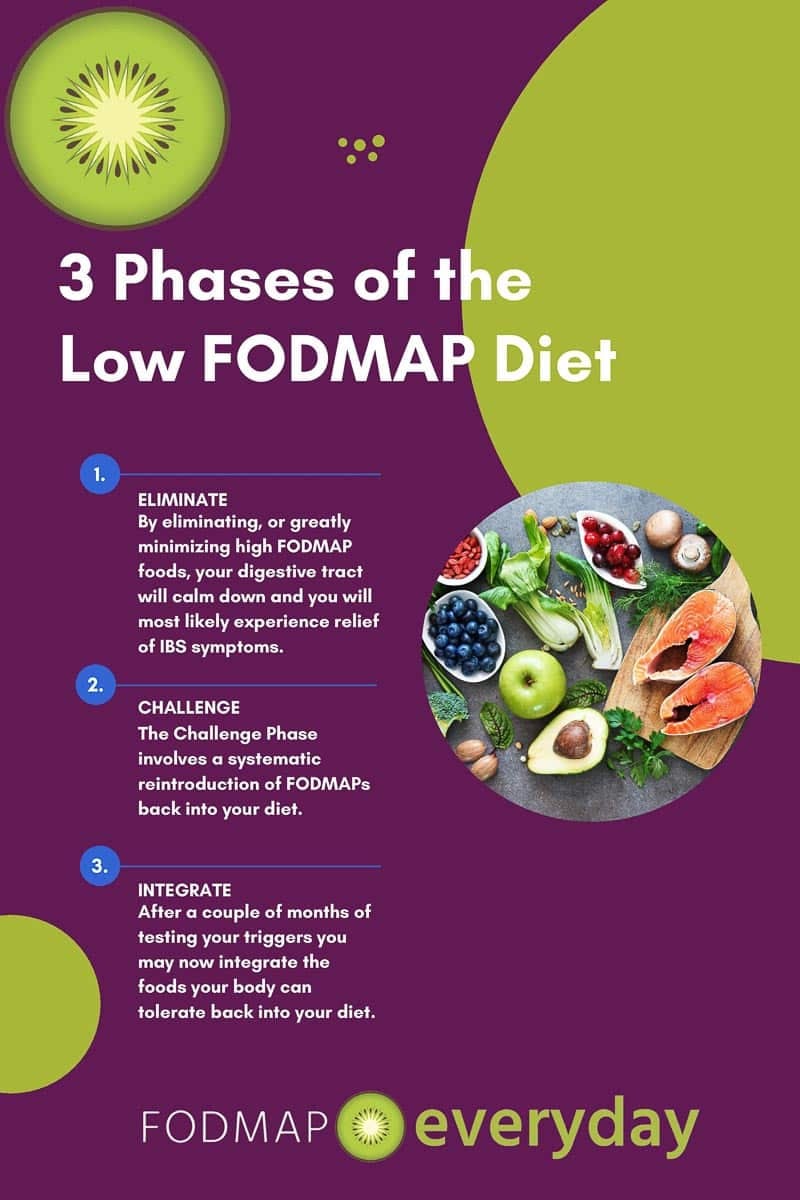
This second phase is the key to food variety, flexibility, and liberation. And, on a nutritional level, this phase is also crucial to your health. By learning your unique triggers, you will be able to expand your food intake, ensure a diversity of nutrients and NOT over-restrict your diet based on food fears or complete elimination of entire food groups.
In short, the Challenge Phase is the key to knowledge, comfort, and perhaps even a return to enjoyment of food. So let’s dive in!
The Challenge Phase is the key to knowledge, comfort, and perhaps even a return to enjoyment of food.
When To Start The Challenge Phase
If you have been following the low FODMAP diet Elimination Phase for 2-6 weeks and you have seen a significant overall improvement in your IBS symptoms, and you have not had any symptoms in at least 3-5 days, you can begin the Challenge Phase. The basic Challenge Phase takes about 8 weeks, and if you decide to do any combined or customized challenges (more on this later), it can take 12 weeks or more.
Time It Right
It is best to begin the Challenge Phase when you have several weeks of relative calm in your life – e.g., you are not planning to travel, you don’t have a huge project at work that is due, you are not ill, etc. During the Challenge Phase, we will be testing foods from different FODMAP groups in varying amounts, and we want to try to reduce the number of variables that may also be affecting our digestive system (e.g., things that could also cause or exacerbate IBS symptoms).
Big changes in our stress levels, sleep, health, diet, or activity levels can cloud the results of our FODMAP challenges, so we want to keep this “noise” to a minimum. Of course, we cannot always control all the areas of our lives, so keeping a journal during the Challenge Phase will be key (more on this later); where we can also track some of these non-food variables.
Goals of the Low FODMAP Diet Challenge Phase
- Understand specific triggers and reduce food fears.
- Ensure sufficient prebiotic fiber intake and an overall healthy gut microbiome.
- Increase nutritional adequacy and variety.
- Sustained reduction of symptoms and improved quality of life.
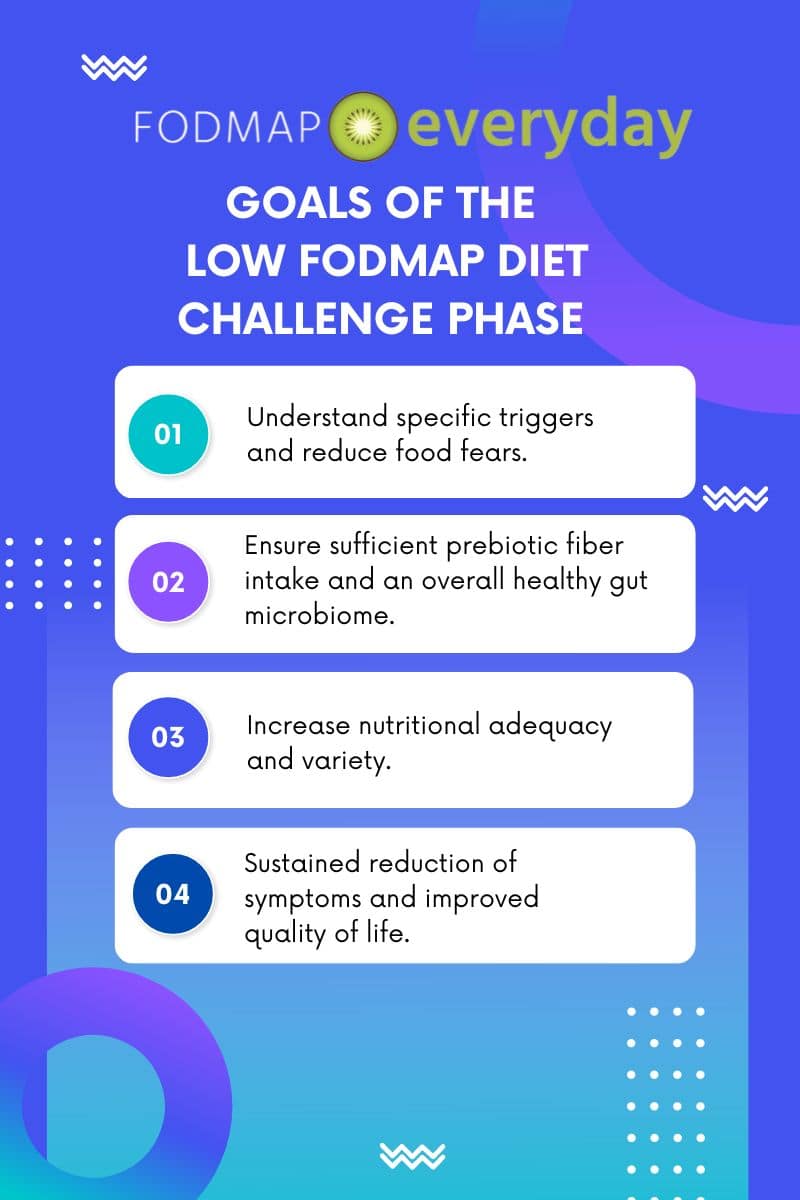
How To Start The Challenge Phase
Ideally, you will work alongside a low FODMAP Diet-trained dietitian, as interpreting the results of your challenges can be tricky. For a list of dietitians, please see our Global Dietitian Directory. If you are not able to access a dietitian, you can use this article and the Monash University low FODMAP diet app to help guide you.
Before beginning any FODMAP challenges, you will want to:
- Organize your life to give yourself some space to calmly undertake these challenges.
- Read all the instructions carefully.
- Decide on your desired challenge schedule.
- Select your one challenge food (high FODMAP foods) for each FODMAP category and make sure you have enough on hand for each of the three challenges.
- Have a challenge journal handy.
- NOTE: If possible, do not start any new medications or supplements during this phase (such as prebiotics or probiotics, as examples) or make any other significant changes to your diet and lifestyle. If your medical condition requires a medication, of course, follow your doctor’s instructions and take as directed.
Challenge Phase Instructions
The Challenge Phase involves selecting a single food from each FODMAP group and eating this same food three different times in increasing quantities over the course of several days. After that, you will wait for 3-5 days before you begin to challenge the next FODMAP category. This is called a “washout period.”
For example, let’s say you select mango from the list of suitable foods to challenge fructose. You will then eat a small amount (the “challenge dose”) of mango on Day 1, a larger amount on Day 2, and the largest amount on Day 3, noting any symptoms that you may experience over the 24 hours after consuming each dose. Then, following the washout period after your last trial of fructose, you will move on to your next FODMAP group, such as lactose, and begin three trials of a single lactose-rich food. And so on.
Timing Your Challenges
In general, there are two different ways to go about the Challenge Phase.
- Daily Challenge Schedule. This is where you eat the different challenge food three days in a row, following the portion size recommendations in the table below in the Challenge Food List & Reintroduction Schedule section.
Then, after completing the 3 consecutive days of challenges, you wait the 3–5-day washout period, and start the next set of FODMAP challenges. This can be a good schedule if you have somewhat limited time to complete all the challenges.
- Alternate Day Challenge Schedule. Here, you skip a day in between each of the three Challenge Doses, and again, wait the 3–5-day washout period before starting your next challenge food. This can be a good option if you are feeling anxious about encountering onset symptoms from challenges and/or prefer a slower pace.
CLICK THE IMAGE TO SEE A LARGER VERSION AND TO DOWNLOAD A PDF
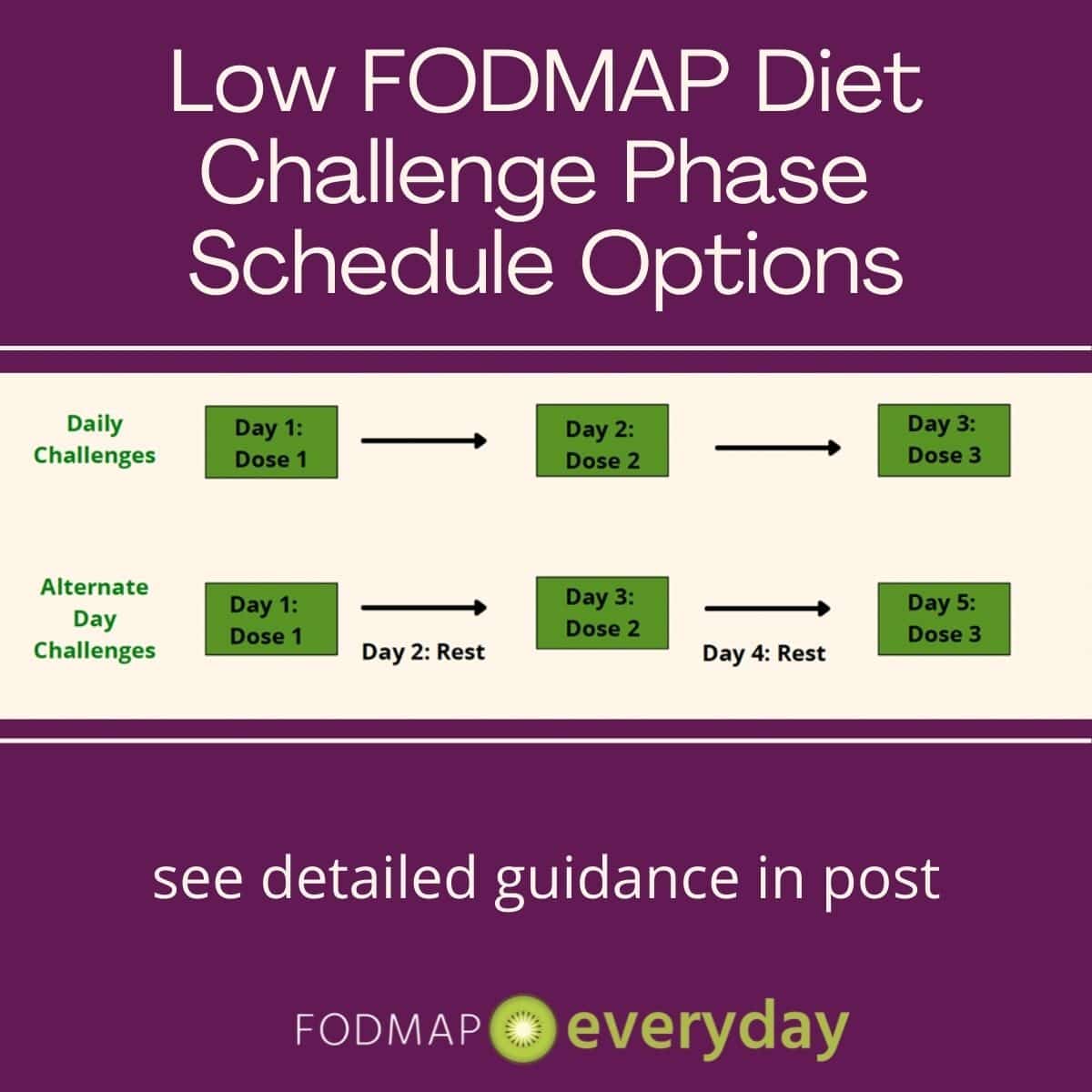
Important Challenge Notes
- During the Challenge Phase you will continue to follow the low FODMAP Diet Elimination Phase guidance (using the Monash University app or guidance from your dietitian to select Low FODMAP or “green light” foods). The only thing that you will change is that each week you will challenge a different FODMAP group.
- Even if you “pass” a challenge and do not experience any symptoms after all three days of challenging a particular food, do NOT reintroduce this food into your daily diet until you’ve finished ALL of your challenges. You will formally reintroduce these foods back into your diet for good during Phase 3: The Integration Phase.
Challenge Food List & Reintroduction Schedule
Once you’ve chosen your desired Challenge Schedule, you’ll want to review the list of Challenge Foods (see below) and select the ones you want to trial. It is important to select ONE single food from each FODMAP group for your challenge. You should not “mix and match” foods during a challenge as this may not provide consistent results. So, if you choose cow’s milk for Day 1 of your lactose challenge, you will stay with cow’s milk for Days 2 and 3 as well.
Reminder: Always wait the 3–5-day washout period before moving on to the next FODMAP category/set of challenges.
CLICK THE IMAGE TO SEE A LARGER VERSION AND TO DOWNLOAD A PDF
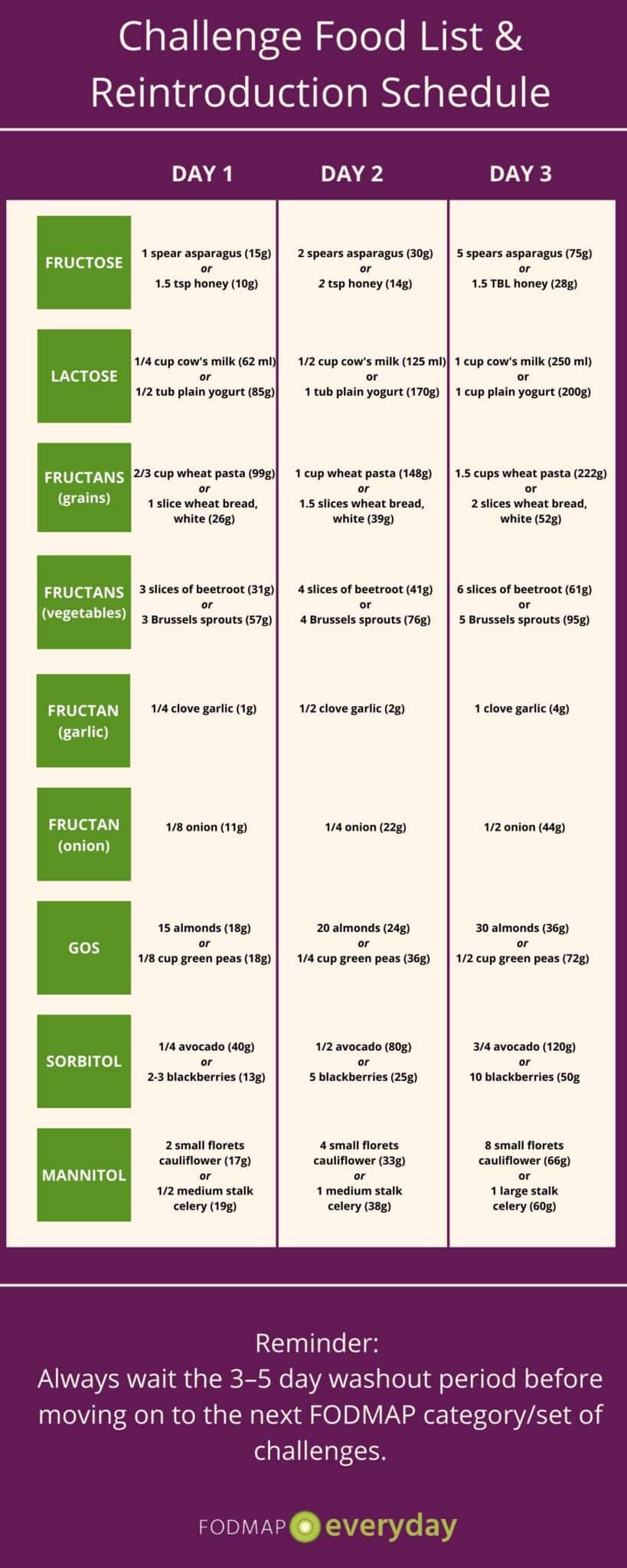
Challenges
You will be conducting a FODMAP reintroduction to all of the following. Note that fructans have four separate challenges:
- Fructose (monosaccharides): Choose from asparagus, honey, mango, sugar snap peas
- Lactose (disaccharides): Use cow’s milk, custard made with cow’s milk, plain yogurt
- Fructans (grains; oligosaccharides): Wheat pasta, wheat cous cous, wheat bread
- Fructans (vegetables and fruit; oligosaccharides): Beetroot, Brussels sprouts, Savoy cabbage, grapefruit, raisins,
- Fructans (garlic; oligosaccharides): Garlic (it is suggested that you use fresh clove of garlic)
- Fructans (onion; oligosaccharides): Any onion
- GOS: Almonds, chickpeas, green peas, silken tofu, whole soy bean milk
- Sorbitol: Apricot, avocado (this might be changing due to persitol), blackberries, yellow peach
- Mannitol: Buttion mushroom, cauliflower, celery, sweet potato, white cabbage sauerkraut
- Fructose + Sorbitol (Polyols): Red apple, cherries, pear
- Fructan + GOS: Wholegrain bread, pearl barley, cashews, pistachios, boiled red kidney beans
Other Challenge Food Options
You can also utilize the Monash University FODMAP app to find additional challenge food options (high-FODMAP foods) and quantities if the food choices above are not what you might typically eat. (To do so, utilize the Symptom Diary feature in the app and then select the apple with the arrow around it to access the Challenge/Reintroduction features. See the icon circled in red below).
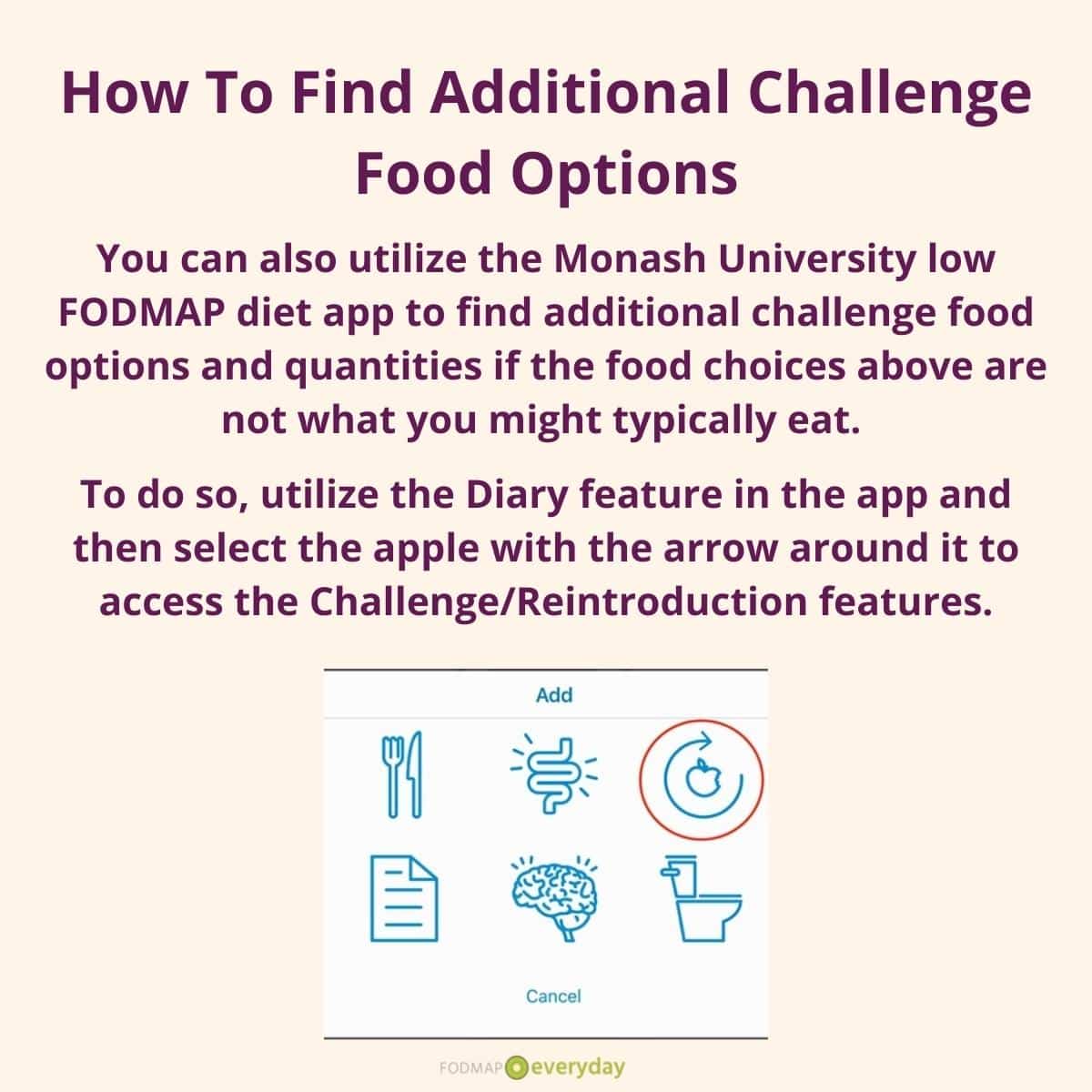
Combination Challenges
In addition to the single-FODMAP challenges listed above, there are several “combination challenges” that you might wish to conduct (after completing the initial group of Challenges), utilizing foods that contain more than one FODMAP type.
This can be helpful for some individuals in further identifying trigger FODMAPs and quantities, or to help clarify somewhat ambiguous results from the initial challenges. For example, certain fruits (such as apples and pears) contain both excess fructose and sorbitol, and if these are foods you really enjoy and would like to add back into your diet, a customized challenge of one of these may be useful. It is best to talk with your dietitian for more details on how and when to complete these challenges.
Ready, Set, Challenge!
You now have all the details you need to begin the low FODMAP diet Challenge Phase, so it’s time to get started.
Begin your challenges, noting any symptoms you may experience within 24 hours after consuming a particular challenge dose. If you experience very strong or unpleasant symptoms, you may stop that challenge (no matter what day or Challenge Dose you are on). Simply wait 3-5 days and then go on to the next FODMAP group. It is not necessary to suffer your way through all three Challenge Doses if you feel unwell!
However, if you experience only mild symptoms , such as light bloating or a few farts, you may wish to wait a day or two, and then move on with completing the final Challenge Doses of that particular food. Your decision to stop or proceed is a personal one, however keeping good notes of symptoms can help you troubleshoot any issues in interpreting the challenges in the future, with the help of your dietitian.
Keep in mind: the goal of the Low FODMAP Diet is not to eliminate symptoms, but to reduce them to a manageable level, while ensuring proper nutrition and optimal health.
The goal of the Low FODMAP Diet is not to eliminate symptoms, but to reduce them to a manageable level, while ensuring proper nutrition and optimal health.
During this time, utilize your Challenge Journal (see sample below) to track the following:
- Keep track of challenge days (your testing days).
- Specific food challenged and quantities consumed.
- Symptoms experienced on any given day (yes/no/which symptoms)
- If you stopped the challenge early.
- You might also want to note any other possible IBS-exacerbating issues going on in your life, such as stress, illness, hormonal fluctuations/menstruation, intense exercise or sporting events, etc.
Top 10 Tips for the Low FODMAP Diet Challenge Phase
- Begin this phase after you have completed at least 2 weeks in the Elimination Phase and your symptoms have been significantly reduced.
- Plan on spending 8-12 weeks completing all challenges. You can “pause” as needed between challenging FODMAP groups, but ensure you are symptom-free for at least 3 days before restarting.
- Continue following the Low FODMAP Diet protocol from the Elimination Phase throughout the entire Challenge Phase (eat only “green light” foods and avoid stacking).
- Test one single FODMAP group at a time.
- Consume the same food 3 times to complete each challenge. Do not combine or switch foods during a challenge.
- If you experience significant symptoms at any point during a challenge, discontinue that challenge. Start the next challenge after the washout period.
- Keep a record of your challenges and your results, as well as any notes or questions.
- Make a list of foods you tolerated very well (Day 3 = moderate or no symptoms), moderately tolerated (Day 2 or 3 some symptoms) and did not tolerate at all (Day 1 = symptoms).
- After completing all challenges, slowly begin adding well- and moderately tolerated foods back into your diet. (The filtering feature in the Monash University Low FODMAP Diet app can be a great tool in navigating the final Integration Phase and personalizing your diet for your personal preferences and tolerances).
- Tolerances can change! If a particular food was not well-tolerated at this time, make a note to re-challenge again in 4-6 months.
Challenges Complete! What’s Next?
You made it! Now that you have finished your challenges, you have the information you need to move on to the final phase: Integration. This is the third and final (and most fun in my opinion) phase of the low FODMAP diet.
The Integration Phase is where you take all you’ve learned about your tolerances (both specific foods and quantities) and begin to integrate these back into your daily routine. This last phase often gets overlooked, but it’s important to your health and well-being to integrate foods in a consistent and somewhat systematic way back into your diet. See our article on the Integration Phase to learn more.
The Takeaway
The low FODMAP diet is three phases: Elimination, Challenge, and Integration. Each is important and they build on top of one another. You will have the best outcome at determining your IBS triggers if you follow the three low FODMAP diet phases in a structured manner.
The Elimination Phase should be short and sweet: in fact, we have an article titled just that, which we suggest that you review.
For the health of your microbiome – and for your positive relationship with food – it is vital to move out of Elimination and into the Challenge Phase, as outlined in this article. It is about establishing more food freedom and moving beyond small serves.
For information on the third low FODMAP diet phase, Integration, for your long-term lower FODMAP approach, read our article The Low FODMAP Integration Phase.
And occasionally you might have to pause your progression through the 3 phases. Please take a look at our article, Pausing The Low FODMAP Diet.
Happy Eating!
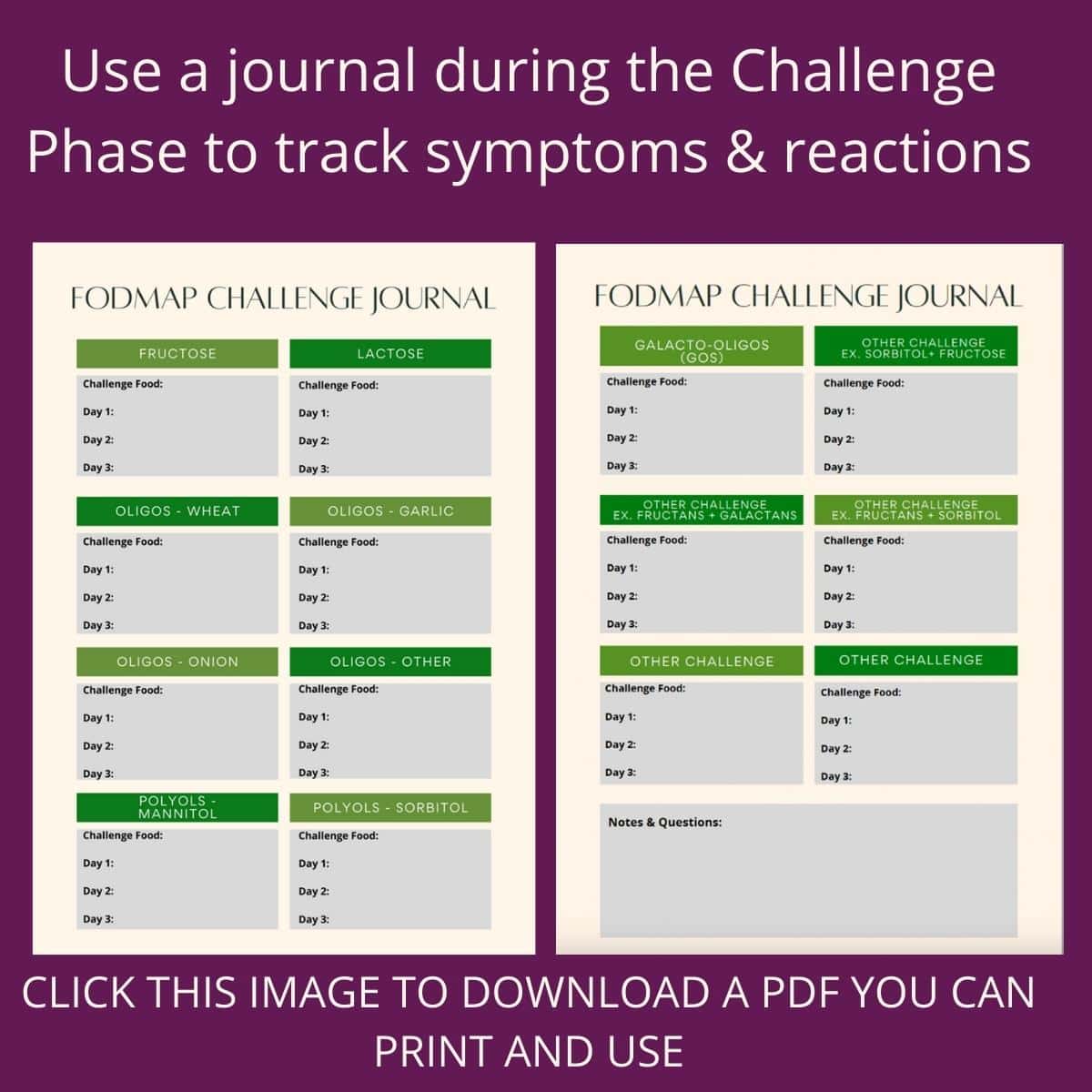
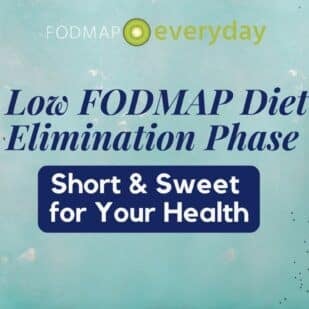
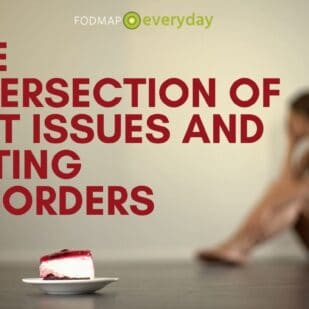






Hi, I’m wondering how does one do the onion and garlic challenge? Can you add that to a low FODMAP food raw or can you saute the garlic/onion?
There are many approaches. Many dietitians will suggest that you test what you eat. After all, that is what you want to learn about, in terms of your reaction. If you usually eat cooked garlic, simply use the amount in a serving size that you will be testing.
I’m currently testing sorbitol. I had 38g of avocado yesterday and about an hour later had to dash to the loo followed quickly by two more visits, and feeling it wasn’t safe to leave the house to walk my dogs. Nothing since then except discomfort and pain, I had a good night apart from bowel pain which I seem to often get (last week the pain was after testing rice, I’m having to test safe food too, and it spiked my blood glucose to over 8). I’m in pain still this morning.
Is my reaction to avocado enough to decide to stop this test? Should I try one more day?
Hi there…a few comments. At an hour, this is not a FODMAP reaction, which you can read more about HERE. So, this question has a two pronged answer. I would not test again until I have given myself a 3 days rest, but also, knowing that this was not a FODMAP reaction makes this more complex. This is exactly the type of reason we suggest working with a dietitian. We cannot give medical advice, as we do not know your complete picture.
Also, we do try to encourage not using the term “safe” (which means there is “unsafe”) for a variety of reasons laid out in this article.
Thanks so much for responding so quickly!